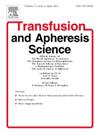Etoposide + cytarabine + pegfilgrastim versus cyclophosphamide + G-CSF for stem cell mobilization in patients with poorly mobilized multiple myeloma and lymphoma
IF 1.4
4区 医学
Q4 HEMATOLOGY
引用次数: 0
Abstract
Background
In multiple myeloma (MM) or lymphoma with poor mobilization, the combination of etoposide, cytarabine (Ara-C), and pegfilgrastim (EAP) appears to have higher mobilization efficacy than cyclophosphamide (Cy) plus granulocyte colony-stimulating factor (G-CSF) (CG) regimens. The purpose of this study was to examine whether there were differences in efficacy and toxicity between the two mobilization regimens.
Methods
All data were collected from Department of Hematology at the Affiliated People's Hospital of Ningbo University from May 2016 to March 2023. And data from EAP regimen were compared with data from the CG regimen.
Results
A total of 43 patients were mobilized by the EAP regimen and 44 patients by the CG regimen. The target yield of 2 × 106 CD34+ cells/kg was achieved in 95.3 % (EAP) and 63.6 % (CG) of patients by 1.3 and 1.6 apheresis (means), respectively. In addition, 76.7 % of patients with EAP regimen and 29.5 % of patients with CG regimen achieved optimal mobilization (≥5 ×106 CD34+ cells/kg) during the first apheresis session. The median number of cumulative collected CD34+ cells was 8.9 (range 2.6–41.3) × 106 CD34+ cells/kg and 4.2 (range 0.1–18.8) × 106 CD34+ cells/kg in the two groups, respectively. Thrombocytopenia gr. 4 was observed in 34.9 % of patients after EAP (CG, 2.3 %) and neutropenia gr. 4 was observed in 58.1 % of patients after EAP (CG, 63.6 %).
Discussion
EAP is an excellent mobilization regimen with acceptable toxicity and could be considered in patients with MM and lymphoma with poor mobilization.
依托泊苷+ 阿糖胞苷+ 聚非格苷与环磷酰胺+ G-CSF对动员不良的多发性骨髓瘤和淋巴瘤患者干细胞动员的影响
背景:在动员能力差的多发性骨髓瘤(MM)或淋巴瘤中,依托泊苷、阿糖胞苷(Ara-C)和聚非格苷(EAP)联合使用似乎比环磷酰胺(Cy)加粒细胞集落刺激因子(G-CSF) (CG)方案具有更高的动员效果。本研究的目的是检查两种动员方案在疗效和毒性方面是否存在差异。方法所有数据收集自宁波大学附属人民医院血液科2016年5月至2023年3月。并将EAP组数据与CG组数据进行比较。结果EAP方案共动员43例,CG方案共动员44例。通过1.3和1.6单采(平均),95.3 % (EAP)和63.6 % (CG)的患者分别达到2 × 106个CD34+细胞/kg的目标产量。此外,76.7 %的EAP方案患者和29.5 %的CG方案患者在第一次单采期间达到最佳动员(≥5 ×106 CD34+细胞/kg)。两组累积收集的CD34+细胞中位数分别为8.9 (2.6-41.3)× 106个CD34+细胞/kg和4.2 (0.1-18.8)× 106个CD34+细胞/kg。EAP术后34.9% %的患者出现了4级血小板减少症(CG, 2.3 %),58.1% %的患者出现了4级中性粒细胞减少症(CG, 63.6 %)。oneap是一种极好的动员方案,毒性可接受,可考虑用于MM和淋巴瘤患者的不良动员。
本文章由计算机程序翻译,如有差异,请以英文原文为准。
求助全文
约1分钟内获得全文
求助全文
来源期刊
CiteScore
3.60
自引率
5.30%
发文量
181
审稿时长
42 days
期刊介绍:
Transfusion and Apheresis Science brings comprehensive and up-to-date information to physicians and health care professionals involved in the rapidly changing fields of transfusion medicine, hemostasis and apheresis. The journal presents original articles relating to scientific and clinical studies in the areas of immunohematology, transfusion practice, bleeding and thrombotic disorders and both therapeutic and donor apheresis including hematopoietic stem cells. Topics covered include the collection and processing of blood, compatibility testing and guidelines for the use of blood products, as well as screening for and transmission of blood-borne diseases. All areas of apheresis - therapeutic and collection - are also addressed. We would like to specifically encourage allied health professionals in this area to submit manuscripts that relate to improved patient and donor care, technical aspects and educational issues.
Transfusion and Apheresis Science features a "Theme" section which includes, in each issue, a group of papers designed to review a specific topic of current importance in transfusion and hemostasis for the discussion of topical issues specific to apheresis and focuses on the operators'' viewpoint. Another section is "What''s Happening" which provides informal reporting of activities in the field. In addition, brief case reports and Letters to the Editor, as well as reviews of meetings and events of general interest, and a listing of recent patents make the journal a complete source of information for practitioners of transfusion, hemostasis and apheresis science. Immediate dissemination of important information is ensured by the commitment of Transfusion and Apheresis Science to rapid publication of both symposia and submitted papers.

 求助内容:
求助内容: 应助结果提醒方式:
应助结果提醒方式:


